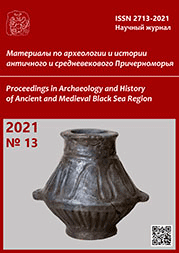Хронологическая последовательность мегалитических погребальных комплексов энеолита в кургане у пгт. Великая Александровка
Chronological sequence of megalithic burial complexes of the Eneolithic in the Velikaya Aleksandrovka burial mound
Author(s): Marina Daragan, Sergey V. PolinSubject(s): History, Archaeology, Cultural history, Economic history, Ancient World
Published by: Нижневартовский государственный университет
Keywords: Eneolithic; Early Bronze Age; Yamnaya culture; megalithic structures; cromlech; stone cist graves; animalistic images; 3D modeling; reconstruction; mound;
Summary/Abstract: The emergence of the earliest burial mounds in the Eneolithic of the North Pontic steppes (3900/3800—3500/3400 BCE) was accompanied by the construction of the earliest megalithic structures — cromlechs, the circular structures of which consisted of vertically installed stone slabs combined with stone chamber burials, cist burials, and pit burials covered with stones. Similar structures continued to be built in the Pit Graves (Yamnaya) Culture period; but for how long they were used back then and what were the burial structure types they related with are the issues so poorly understood to date. Currently, all these megalithic structures are not visible on the surface of the burial mounds, since they are hidden from view beneath later earth structures built above Pit Graves Culture burials. When studying how such megaliths were built, stage by stage, one has the most effective tool at one’s disposal to reveal the cultural genesis of various burial traditions as they have emerged in a particular area. Among various burial structures ever discovered in the steppe zone of the Northern Black Sea region, the earliest burials explored in the burial mound No.1 near Velikaya Alexandrovka are of special significance. Here, the earliest burials of the Velikaya Alexandrovka Mound (No.22-24, and No.7) with associated megalithic structures (stone circles No.1 & No.2) are discussed. Also, zoomorphic images representing an aurochs and a scene with dogs chasing a wild boar were found engraved on two slabs from the cromlech No.1. The article introduces Eneolithic burials recovered in the mound, a graphic reconstruction of the appearance of the cromlechs associated with them, and the results of morphometric analysis of images engraved on cromlech slabs. The cultural and chronological attribution of the burials is considered in detail. Particular attention is paid to the position cist burials have held within the stratigraphy of the Pit Graves burial mounds as well as to the patterns by which cist burials and cromlechs were associated. The following data are considered: (1) cromlech structures of the Eneolithic and those encircling Pit Graves Culture burials; (2) cromlechs enclosing Eneolithic burials and Pit Graves Culture cists together; (3) cist burials located on the tops of Eneolithic burial mounds; (4) cist burials introduced into Eneolithic mounds; (5) chief burials in ornamented cists with no stone structures encircling them; (6) cist burials made on the surface of mounds of the Pit Graves Culture period, and (7) cist burials introduced into Pit Graves Culture mounds.
Journal: Материалы по археологии и истории античного и средневекового Причерноморья
- Issue Year: 2021
- Issue No: 13
- Page Range: 13-98
- Page Count: 86
- Language: Russian

